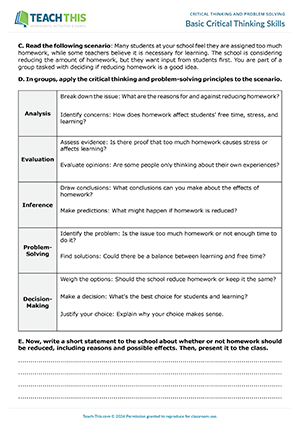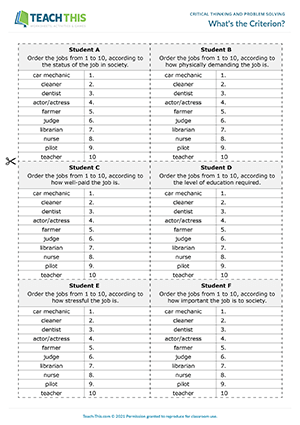Here is a useful critical thinking and problem-solving worksheet and activity to help students learn and apply basic critical thinking and problem-solving concepts and principles. First, students complete sentences about critical thinking and problem solving with related words from a box. Students then write the sentence number next to the feature of critical thinking or problem solving it is describing. Next, in groups, students read a scenario that outlines an issue regarding homework at a school. In their groups, students apply the critical thinking and problem-solving principles to the issue and make notes on their answers in a chart. After that, each group prepares a short statement that communicates their recommendation for addressing the homework issue and then presents it to the class. After hearing each statement, the class asks the group follow-up questions. Finally, the class votes on which group's recommendation they think would be most effective and discusses why that solution stood out and what makes it particularly compelling.
In this interesting critical thinking activity, students prioritize and discuss the most important qualities of an ideal partner. First, students read a list of qualities that an ideal partner might have and mark the ten most important ones with a tick. Next, in pairs, students find out which ten qualities their partner chose and mark down their answers. After that, students discuss the answers with their partner and explain the reasons for their choices. Then, from the items they have both ticked, students compromise and choose the five most important qualities, arranging them from 1 to 5, with number 1 being the most important. Each pair then joins with another pair and compares their five most important qualities. Finally, each group gives feedback to the class on their most popular qualities for an ideal partner.
In this insightful critical thinking activity, students use a framework to look at the topic of stress and evaluate stress reduction and relaxation methods. Students begin by completing a framework that can be used to evaluate solutions with words from a box. Students then interview a partner about the top five most stressful things in their life and their effects with 1 being the most stressful. Next, students compare and discuss their answers with another pair, come up with the top five most stressful things for their group, and write down the effects of each stressful thing. After that, students conduct a survey to find out what stress reduction and relaxation methods their classmates use. Students then move on to read the responses and score each stress reduction and relaxation method according to the four criteria from the framework, effectiveness, feasibility, efficiency and sustainability. Finally, students rejoin their group and discuss their three highest-scoring methods and questions related to the framework.
In this fun critical thinking game, students guess what criterion their classmates used to put a list of ten jobs in order. Working alone, students order jobs on their card, according to the given criterion with 1 being the most important. Next, students use their critical thinking and analyzing skills to guess what criterion other students used to put their list of ten jobs in order. Students then take turns reading out their job order from 1 to 10. The other students in the group analyse the list and discuss the possible criterion, explaining their reasoning for guessing a specific criterion and thinking critically about their assumptions and logic. After that, each student gives their answer to the student who read out the order. The student then reveals the correct criterion. Students who guessed correctly each score one point. The student with the most points at the end of the game wins. Finally, discuss the job order for each criterion with the class and see if the students can agree on a ranking for each.
This intriguing critical thinking activity provides an opportunity for students to use their critical thinking skills to discuss a set of controversial questions. In groups of four, students read a set of question strips and choose three to discuss. Students then have ten minutes to brainstorm different perspectives on the selected questions by exploring arguments for and against each question. Next, students discuss each question for five minutes, supporting their opinions with evidence and reasoning using credible sources or personal examples, drawing a conclusion at the end. After discussing all three questions, each group presents their conclusions to the class. After each group has presented, the class asks questions that challenge the group's assumptions. Afterwards, students give feedback on which group they thought came up with the best conclusions.
In this free desert island survival game, students use their critical thinking and problem-solving skills to survive being stranded on a desert island. Students imagine that their boat is sinking and that there is a desert island nearby. In groups, students choose four items from the worksheet to help them survive on the island and explain why they chose each one. Next, groups find out what challenge they face on the island by choosing a card. Groups then read the challenge and make a plan on how they are going to survive on the island using the four items to help them. Afterwards, groups take turns reading their challenge and presenting their ideas to the class. Assess each group's chances of survival and score each group between one and three points according to their ideas. After each group has presented, they roll a dice and the awarded points are combined with the number on the dice. Groups need to score four or more to survive. A score of six or more is needed to thrive on the island.
In this communicative problem-solving activity, students use their critical thinking and problem-solving skills in order to survive an imaginary emergency. To start, students read a background story about a plane crash. In groups, students then discuss the ways they would face the emergency situation in the story and pick five items to help them survive, writing down the reasons for their five choices, e.g. a mirror for signalling rescuers by day. Groups then take turns explaining their choices to the class, who give feedback on their ideas. The class then votes to see if the group could survive using the items or not. Next, the class discusses their solutions and comes up with a list of the five best survival items from the worksheet. Afterwards, groups practice conveying important information in an SOS emergency call in the most effective way possible. The students' task is to call a rescue team and explain where they are and the situation in one minute. Students practice the emergency call first in their groups and then perform it to the class.
In this engaging critical thinking activity, students practice and reflect on zero-sum negotiations. Students imagine they have been given $100 that they must divide with their partner, but they must aim to secure at least the amount indicated on their goal card. This is a zero-sum negotiation, meaning any gain for one student is a loss for the other. Students then have five minutes to negotiate with their partner for a share of the money with each student using their own story or tactic to justify why they need the money. When the time is up, students reveal their goal cards to their partners. Students then share their goals and the results of their negotiation with the class. Next, students change partners and repeat the zero-sum negotiations as before using the instructions on a new card to influence how the negotiation goes. After an agreement has been reached, students reveal their role and goal card to their partner. Lastly, students answer discussion questions, reflecting on their experiences and then discuss them as a class.
Latest Free
Resources
- Identifying and Clarifying Problems
Dealing with Problems (B2)
Date Added: 1st of November
- The Bus Stop
Getting Around (B1)
Date Added: 1st of October
- Study Skills Showdown
Study Skills (B2)
Date Added: 10th of September
- Everyday Objects Bingo
Everyday Objects (A1-A2)
Date Added: 25th of August
- Action Verb Races
Actions (A1-A2)
Date Added: 18th of August
Latest Member
Resources
- Editing in Action
Writing Exam Preparation (B1)
Date Added: 9th of January
- My Favourites
Likes and Dislikes (A1)
Date Added: 9th of January
- Birthday Bonanza
Birthdays (A2)
Date Added: 9th of January
- Birthday Banter
Birthdays (B1)
Date Added: 8th of January
- Where is it?
Giving Directions (A1-A2)
Date Added: 7th of January











